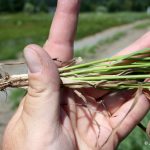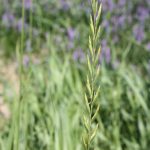Quackgrass
Prepared by Jennifer L. D’Appollonio, Assistant Scientist, University of Maine, Orono, ME 04469. Updated February 2018.
Scientific name: Elymus repens (L.) Gould; old Agropyron repens L. (Beauv.)
Common name(s): quackgrass, couch grass, dog grass, quickgrass, scutch, quitch, twitch, witchgrass, creeping wild-rye
Link(s): USDA PLANTS Profile, Go Botany
Images: (to see enlargements [PC]: click on image, then right click and choose “view image”)
- June
- July
- root system in June
- root system in July
- leaf detail
- note hairs on upper leaf surface only
- mid-June; note awns
- seedheads in June
- in flower, early July
- seedhead in July, no awns
- inflorescence is variable
Description:
– perennial
– reproduces by seed and running stalk (rhizomes).
– flowers July to Sept.
– inflorescences are variable – can also have awns of varying length (awns: aka the “bristles” on a head of wheat)
– considered an invasive species
-Stems 1′ to 4′ tall with sheaths usually shorter than internodes
-Leaf blades are 3″ to 12″ long and 1/8″ to 3/8″ wide
- smooth beneath and rough above. Ligule very short
– may be confused with E. trachycaulus, which does not have rhizomes, or possibly Thinopyrum pycnanthum in ME fields abutting a coastal beach or marsh; see left sidebar on Go Botany webpage
Habitat:
-disturbed sites
-meadows and fields
-shores of rivers
Sources:
Go Botany. “Elymus Repens (L.) Gould.” Elymus Repens (Creeping Wild-Rye): Go Botany, 2021, gobotany.nativeplanttrust.org/species/elymus/repens/.
Acknowledgement(s):
Eric T. Doucette, Ph.D. – Assistant Professor of Biology, MA College of Liberal Arts, North Adams, MA (updated Feb 2018)











